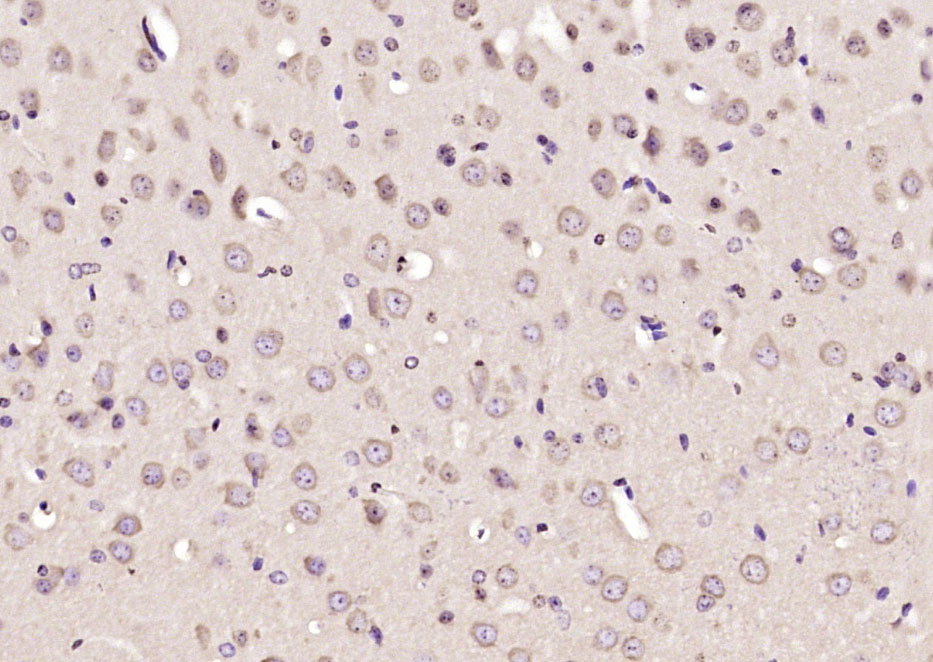
Rabbit Anti-COMMD10 antibody
COMM domain containing 10; COMMD 10; FLJ11285; HGNC:30201; HSPC305; PTD002.
View History [Clear]
Details
Product Name COMMD10 Chinese Name 铜代谢结构域蛋白10抗体 Alias COMM domain containing 10; COMMD 10; FLJ11285; HGNC:30201; HSPC305; PTD002. Research Area Cell biology immunology Epigenetics Immunogen Species Rabbit Clonality Polyclonal React Species Mouse, (predicted: Human, Rat, Rabbit, ) Applications ELISA=1:5000-10000 IHC-P=1:100-500 IHC-F=1:100-500 IF=1:100-500 (Paraffin sections need antigen repair)
not yet tested in other applications.
optimal dilutions/concentrations should be determined by the end user.Theoretical molecular weight 21kDa Cellular localization The nucleus cytoplasmic Form Liquid Concentration 1mg/ml immunogen KLH conjugated synthetic peptide derived from human COMMD10: 91-190/190 Lsotype IgG Purification affinity purified by Protein A Buffer Solution 0.01M TBS(pH7.4) with 1% BSA, 0.03% Proclin300 and 50% Glycerol. Storage Shipped at 4℃. Store at -20 °C for one year. Avoid repeated freeze/thaw cycles. Attention This product as supplied is intended for research use only, not for use in human, therapeutic or diagnostic applications. PubMed PubMed Product Detail COMMD or COMM is a new family of proteins with homology to MURR1, a multifunctional protein that inhibits NFkB. These proteins form multimeric complexes and were identified in a biochemical screen for MURR1-associated factors. The family is defined by the presence of a conserved and unique motif termed the COMM (copper metabolism gene MURR1) domain, which functions as an interface for protein-protein interactions. The proteins designated as COMMD or COMM domain containing 1-10 are extensively conserved in multicellular eukaryotic organisms and define a novel family of structural and functional homologs of MURR1. The prototype of this family, MURR1/COMMD1, suppresses NFkB not by affecting nuclear translocation or binding of NF-kappaB to cognate motifs; rather, it functions in the nucleus by affecting the association of NF-kappaB with chromatin.
Function:
Promotes ubiquitination of NF-kappa-B subunit RELA and its subsequent proteasomal degradation. Down-regulates NF-kappa-B activity. Down-regulates SOD1 activity by interfering with its homodimerization. Plays a role in copper ion homeostasis. Can bind one copper ion per monomer. May function to facilitate biliary copper excretion within hepatocytes.
Subunit:
Monomer and homodimer. Interacts (via COMM domain) with COMMD2, COMMD3, COMMD4, COMMD5, COMMD6, COMMD7, COMMD8 and COMMD10 (via COMM domain). Identified in a complex with an E3 ubiquitin ligase complex composed of TCEB1/elongin C, CUL2, SOCS1 and RBX1. Interacts directly with SOCS1 and CUL2. Interacts directly the N-terminal region of ATP7B. Interacts with CCS, CDKN2A, RELA and NFKBIB. Identified in a complex with NF-kappa-B. Interacts with CLU.
Subcellular Location:
Nucleus. Cytoplasm. Note=Shuttles between nucleus and cytosol. Detected in perinuclear foci that may be aggresomes containing misfolded, ubiquitinated proteins.
Tissue Specificity:
Ubiquitous. Highest expression in the liver, with lower expression in brain, lung, placenta, pancreas, small intestine, heart, skeletal muscle, kidney and placenta.
Post-translational modifications:
Ubiquitinated; undergoes both 'Lys-63'- and 'Lys-48'-linked polyubiquitination. Ubiquitinated by XIAP, leading to its proteasomal degradation.
Similarity:
Contains 1 COMM domain.
SWISS:
Q9Y6G5
Gene ID:
51397
Database links:Entrez Gene: 51397 Human
SwissProt: Q9Y6G5 Human
Unigene: 483136 Human
Product Picture
References (0)
No References
Bought notes(bought amounts latest0)
No one bought this product
User Comment(Total0User Comment Num)
- No comment



 +86 571 56623320
+86 571 56623320
 +86 18668110335
+86 18668110335

